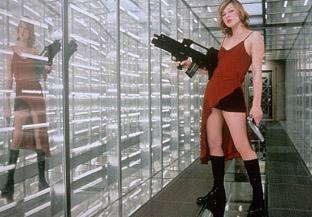What Went Right: Resident Evil Part I
By Shalimar Sahota
September 11, 2012
Anderson decided to make the film a prequel to the first game, explaining how the zombie outbreak begins at a secret underground laboratory called The Hive, controlled by the Umbrella Corporation. One of their experiments is the T-Virus, initially created to extend life. Unfortunately one of the side-effects is that it brings the dead back to life. After one of the vials containing the virus is leaked into the atmosphere, The Hive’s artificially intelligent security system, the Red Queen, contains the threat by sealing the laboratory and killing everyone within. Later, a “not-so-special” military unit working for Umbrella breaks into The Hive to find out what happened. On their way they find a security guard, Alice (Milla Jovovich), who has lost her memory.
Apart from the creatures, it was an unusual and risky move to not feature any of the characters from the world of the videogames. Milla Jovovich’s Alice was created specifically for the film. Following on from the dog kicking action she undertakes, she has since remained as a lead character in all the sequels. In an interview, Anderson said, “To be scary you have to be unpredictable, and that’s why I felt completely free to reinvent the story and use my own set of fresh characters…the suspense dynamic of who is going to live, who is going to die and what people’s allegiances are, was only going to work with new characters.” While one could argue that the appeal of seeing a movie-tie in would be a recognizable story and characters, Anderson’s “unpredictable” approach made just as much sense. Why make a film that follows the story of the game so closely only for the players to know exactly what will happen? Now try and imagine the reaction if someone were to adapt a book the same way and not include any of the characters.
The film did incorporate a few notable motifs, be it the way the Licker creature is introduced, characters running out of ammo, and an underground train finale clearly inspired by the conclusion of the game Resident Evil 2. Towards the end of the shoot it was picked up for distribution by Sony’s Screen Gems, who has since distributed all the Resident Evil films.
The film ended with one of the best teases you could possibly give to any fan of the videogames, closing with a shot that shows Alice arming herself in a desolate and ruined road in Raccoon City. If Anderson wanted to bring audiences back for a sequel, then this shot successfully accomplished that task. Subsequently each film has ended with a pullback shot that teases audiences as to what they can expect in the next installment.
Resident Evil ended up costing $33 million. Released in the US in March 2002, reviews were not good. It opened to $17.7 million and finished its run with $40 million. However, a worldwide total of $102 million put the film in profit. It also managed to help revitalize zombie movies. The following year saw 28 Days Later, while the year after that saw the Dawn of the Dead remake, Shaun of the Dead and another Resident Evil film.
Continued:
1
2
3
|
|
|
|




